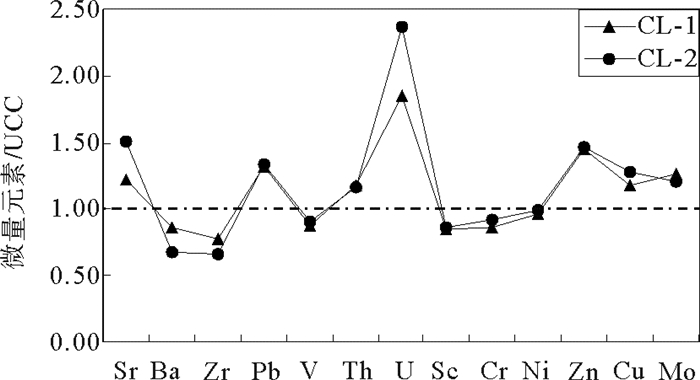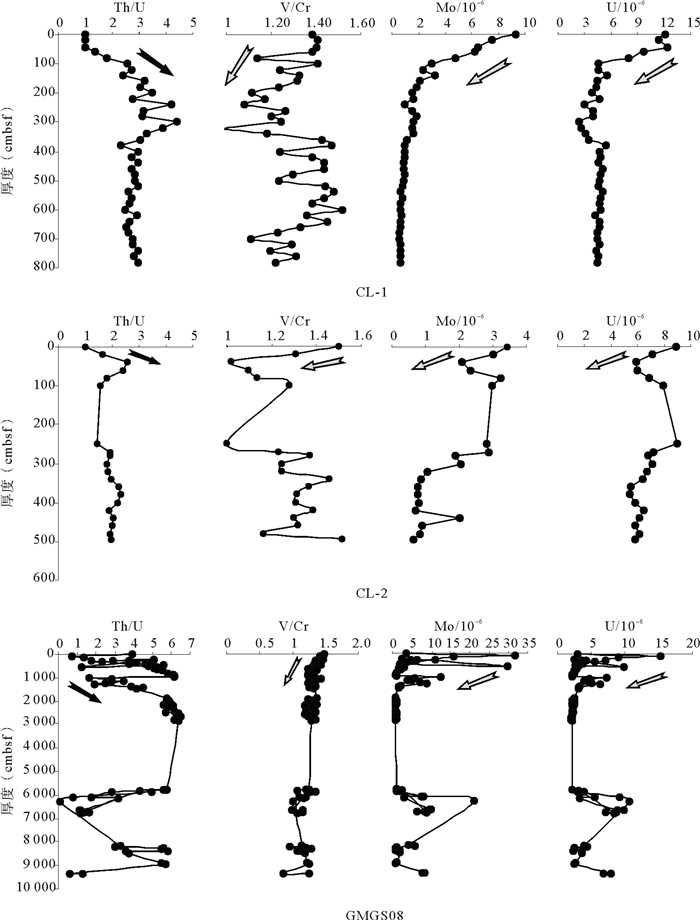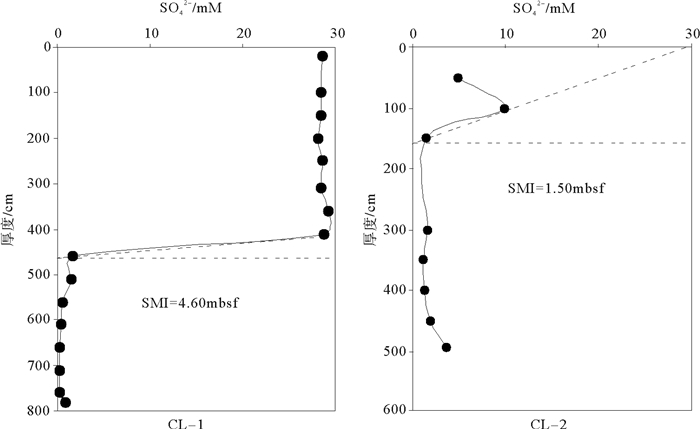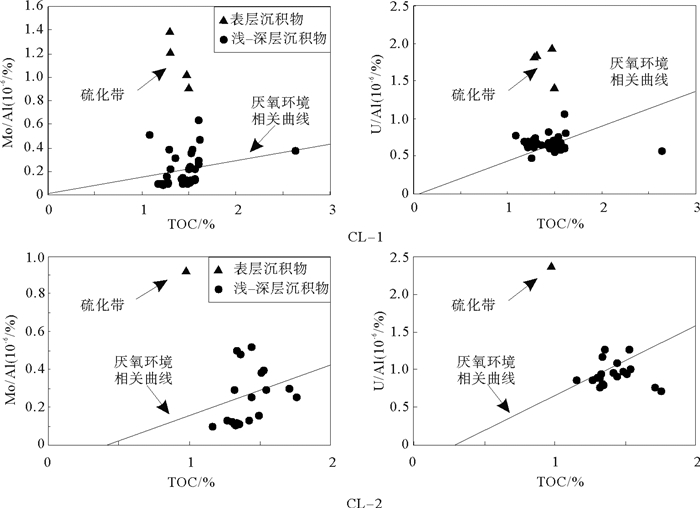TRACE ELEMENT GEOCHEMISTRY OF SEDIMENTS IN QIONGDONGNAN AREA, THE SOUTH CHINA SEA, AND ITS IMPLICATIONS FOR GAS HYDRATES
-
摘要: 天然气水合物已成为重要的战略资源。为探讨天然气水合物富集区的微量元素特征及其指示意义,对琼东南海域沉积物进行系统采样,分析了样品主、微量元素和TOC地球化学特征,并采用氧化还原状态以及氧化还原敏感元素与TOC相关关系的分析方法进行探讨。结果显示:沉积物相较于上地壳更为富集Sr、Pb、Th、U、Zn、Cu和Mo元素,Th/U和V/Sc比值在纵向上呈系统的变化,表层沉积物处于还原的沉积状态,大量富集Mo和U。初步推断研究区部分沉积物可能处于硫化带,使其出现氧化还原敏感元素(Mo和U)的富集,这些特征或由下部天然气水合物分解释放大量的甲烷所导致。表层沉积物孔隙水中出现的硫化带以及Mo和U元素异常,可作为新的地球化学指标以识别下部可能存在的天然气水合物资源。Abstract: In order to study the geochemical characteristics of trace elements and their implications for gas hydrate, marine sediment samples were systematically collected from the Qiongdongnan area of the South China Sea.The major and trace elements as well as the TOC of the sediments are analyzed, upon which the redox condition, redox-sensitive elements and their TOC correlation are adopted to describe the geochemistry characteristics of sediments.The results indicate that Sr, Pb, Th, U, Zn, Cu and Mo are enriched in the sediments comparing to the average of upper crust.Systematic variations in Th/U, V/Cr values further indicate that the sediments are under a more reducing condition, and as the results, Mo and U are enriched.Some sediment samples have already dropped into the sulfide zone, leading the enrichment of redox-sensitive elements such as Mo and U, owing to the dissociation of gas hydrate and methane fluxes coming from deeper sediments.Therefore, the existence of the sulfide zone and Mo and U enrichment in sediments may have the significance to trace the gas hydrates in deep.
-
Keywords:
- trace elements /
- marine sediments /
- H2S /
- gas hydrate /
- Qiongdongnan area
-
天然气水合物是在高压低温环境下由甲烷、乙烷和二氧化碳等气体和水分子组成的似冰状固态物质,俗称“可燃冰”,是解决未来能源枯竭问题的重要战略资源[1-3]。对天然气水合物的识别和勘探一直是地质学研究的热门领域[4-6],传统的勘探方法主要集中在地球物理方面[7-9],其中最为典型的为似海底反射层(Bottom Simulating Reflector, BSR)的识别。但钻探的结果表明,部分BSR与天然气水合物矿藏之间并非一一对应[10]。因此,对天然气水合物的探测和识别方法有待进一步的深化。目前,地球化学勘探技术已经得到逐步的运用[11-13],碳和硫等稳定同位素[14-18]、碘同位素[19, 20]和阴阳离子浓度[10, 21]等地球化学方法已经广泛应用于天然气水合物的识别和研究当中。
微量元素也常作为天然气水合物的地球化学识别标志,沉积物中钡[22-24]和稀土元素[25]等异常特征可作为有效的判别指标。近期,海底冷泉和甲烷渗漏作用亦可通过氧化还原敏感元素(如:Mo和U)的地球化学特征进行追踪[26-28]。然而,类似的前期工作主要集中于墨西哥湾、刚果-安哥拉大陆边缘和中国南海北部东沙海域,作为我国天然气水合物最具勘探潜力区域之一的南海琼东南海域沉积物中的氧化还原敏感元素特征却一直鲜有报道。并且,利用微量元素判断氧化还原状态对甲烷渗漏情况的识别工作具有重要意义。本文对中国南海琼东南盆地沉积物进行了长柱状地质取样,分析了其主、微量元素和总有机碳(TOC)地球化学特征,旨在探讨:(1)沉积物微量元素地球化学特征;(2)氧化还原状态的变化情况;(3)微量元素特征对深部甲烷渗漏和天然气水合物成藏的指示意义。
1. 地质背景
研究区域位于南中国海北部陆缘琼东南海域(图 1),该海域以琼东南盆地为主体,发育在海南岛隆起和西沙隆起之间,盆地基底由古生代变质岩、白云岩、白垩纪中酸性花岗岩、闪长岩和火山碎屑岩组成[11]。琼东南盆地呈北东向展布,面积达4.5×104 km2,新生界最大沉积厚度约12 km,是我国常规油气富集区[10]。区域内可见泥火山、泥底辟、气烟囱、构造断裂和海底冷泉,这些特征是深部天然气水合物发育的有效标志。近年来,琼东南海域已勘探发现天然气水合物实物样品[29],陈多福等[30]预测该地区水合物远景储量约为10×109 m3。
2015年广州海洋地质调查局“海洋四号”船对研究区开展了2个站位的长柱状取样,其剖面岩性特征如下:
CL-1站位水深1 400 m,取样深度780 cm,岩性主要为灰绿色至灰黑色黏土质粉砂,320~400 cm处粒度变粗为粉砂质砂。100~140、180~200、240~250、310~360 cm为粥状沉积层,360~380 cm层段见有气逸构造,292 cm见少量1~5 cm大小的自生碳酸盐颗粒。
CL-2站位水深1722m,取样深度495cm,岩性以灰绿色至灰黑色黏土质粉砂为主。90~110、340~360、390~510cm为粥状沉积层,300~340 cm处气逸构造明显。
2. 样品分析方法
对2个站位共60个沉积物样品进行了有机碳、微量元素和部分主量元素分析,样品经烘干粉碎并研磨至200目待测,简要分析流程如下:
有机碳:实验标准遵守国标规范GB17378.5-2007。在浓硫酸介质中,加入一定量的标准重铬酸钾,在加热条件下将样品中有机碳氧化成二氧化碳,剩余的重铬酸钾用硫酸亚铁标准溶液回滴,按照重铬酸钾的消耗量,计算样品中有机碳的含量。
主量元素:称取0.6 g样品和6 g的Li2B4O7-LiBO2-LiF混合熔剂(质量比为4.5:1:0.4),在铂-金合金坩埚内混匀于高频感应熔样机上制得熔融玻璃片。
微量元素:称样约0.1 g置于Teflon溶样罐中,然后加入4 mL 50%的HCl、10 mL纯HF和2 mL纯HClO4,置于电热板加热蒸干溶液,之后加入4 mL 50%的HCl至充分溶解,加超纯水冲洗加热至溶液澄清透亮约30 min后,冷却并定容至25 mL待测。
样品中有机碳、主量和微量元素测试在国土资源部海底矿产资源重点实验室完成,主量元素使用PANalytical X荧光光谱仪AXIOS XRF对制得的熔融玻璃片进行检测,检测限为0.01%~0.10%。微量元素在电感耦合等离子质谱(ICP-MS)上完成,选取国家标准物质GBW07309、GBW07315和GBW07333作为外部标准,测试相对标准偏差低于5%。
3. 结果
样品分析结果已列入表 1和表 2中。主要源于陆源碎屑的Al2O3含量无明显规律,平均值为12.71%(±2.79, n =60)。TOC含量两个站位无明显差别,平均为1.42%(±0.22, n=60)。与上地壳平均值[32]相比,沉积物中Sr、Pb、Th、U、Zn、Cu和Mo等微量元素较为富集,富集系数总体上呈现U>Sr>Zn>Pb>Cu>Mo>Th>Cr>V>Sc>Ba>Zr。其中,除了Ba、Mo、Zr和Th之外,其余元素在CL-2站位的含量均高于CL-1(图 2)。氧化还原敏感元素如:U在CL-1和CL-2的平均值分别为5.18×10-6(±2.28, n =40)和6.63×10-6(±1.02, n =20),Mo在两个站位中平均含量分别为1.90×10-6(±0.73, n =40)和1.80×10-6(±0.35, n =20),Zn分别为103×10-6(±15.5, n=40)和104×10-6(±11.3, n =20),Ni分别是42.5×10-6(±7.99, n =40)和43.9×10-6(±6.60, n =20),而V的平均含量分别为93.4×10-6(±11.4, n =40)和96.2×10-6(±10.8, n =20)。在纵向上,两个站位随深度的增加,U和Mo的含量呈快速递减的趋势(图 3)。
表 1 CL-1站位沉积物主、微量和TOC分析结果(10-6)Table 1. Major, trace elements and TOC concentrations of sediments at site CL-1(10-6)样品号 厚度/cm Sr Ba Zr Pb V Th Cu Sc CL-1-1 0 505 402 119 22.8 96.8 12.0 32.3 12.2 CL-1-2 20 577 375 124 21.2 89.5 11.3 32.5 11.1 CL-1-3 45 599 428 118 21.9 89.4 12.1 35.3 11.1 CL-1-4 60 459 471 135 22.9 92.6 13.0 31.3 11.2 CL-1-5 80 335 401 147 24.3 101 14.5 32.9 12.5 CL-1-6 100 281 414 206 21.3 79.0 11.7 21.2 9.51 CL-1-7 120 323 437 211 21.9 83.9 12.4 22.9 10.2 CL-1-8 140 352 400 160 23.8 93.9 13.4 25.9 11.5 CL-1-9 160 281 418 181 24.4 99.4 14.4 28.4 12.7 CL-1-10 180 305 398 171 24.9 102 13.4 28.6 12.6 CL-1-11 200 259 406 197 23.1 92.4 13.5 24.4 12.1 CL-1-12 220 305 483 192 23.2 93.4 13.0 28.1 11.8 CL-1-13 240 228 404 242 21.8 84.8 12.5 22.3 11.0 CL-1-14 260 338 427 173 23.1 94.5 12.7 27.1 12.1 CL-1-15 280 322 388 205 21.7 82.8 12.4 20.5 10.4 CL-1-16 300 411 355 208 21.8 71.0 10.8 17.3 7.23 CL-1-17 320 411 366 230 19.8 58.6 10.5 13.5 6.85 CL-1-18 340 441 341 215 19.9 57.7 10.2 12.1 6.46 CL-1-19 360 570 589 140 20.9 74.7 10.8 22.2 8.84 CL-1-20 380 498 461 117 24.1 97.4 12.7 35.1 11.3 CL-1-21 400 455 477 126 24.4 103 14.0 35.1 12.8 CL-1-22 420 428 471 126 24.9 105 13.2 35.1 12.5 CL-1-23 440 415 499 127 23.9 108 13.8 36.4 12.8 CL-1-24 460 446 502 124 22.7 101 13.6 36.5 12.5 CL-1-25 480 449 507 124 24.0 102 13.6 35.1 12.4 CL-1-26 500 439 432 124 24.2 97.3 13.5 33.5 12.0 CL-1-27 520 462 458 120 23.4 100 13.4 35.6 12.0 CL-1-28 540 465 466 116 23.3 99.3 13.1 35.1 12.1 CL-1-29 560 467 514 116 23.5 102 13.1 36.7 12.4 CL-1-30 580 476 503 117 22.2 98.9 12.4 34.8 11.9 CL-1-31 600 507 516 119 21.0 99.8 12.1 33.7 11.9 CL-1-32 620 480 549 121 21.7 99.2 12.4 31.7 12.3 CL-1-33 640 506 522 122 19.8 98.9 12.4 32.3 12.0 CL-1-34 660 503 533 119 21.5 95.4 11.9 30.7 11.6 CL-1-35 680 492 550 117 20.8 96.4 11.8 30.1 11.7 CL-1-36 700 497 596 120 20.9 98.1 12.3 30.3 12.4 CL-1-37 720 469 591 121 22.8 99.0 12.9 30.1 12.4 CL-1-38 740 454 567 119 21.9 97.0 12.8 29.9 12.4 CL-1-39 760 466 608 119 22.1 102 12.7 31.7 12.5 CL-1-40 780 446 597 121 22.7 97.8 13.3 29.4 12.7 样品号 Cr Ni Zn U Mo Al/% TOC/% Th/U V/Cr CL-1-1 69.9 55.0 119 12.1 9.31 6.72 1.29 0.99 1.38 CL-1-2 63.5 47.2 104 11.4 7.54 6.25 1.31 0.99 1.41 CL-1-3 63.8 49.5 109 12.3 6.45 6.36 1.47 0.98 1.40 CL-1-4 66.8 44.8 104 9.65 6.18 6.87 1.50 1.35 1.39 CL-1-5 88.8 46.7 109 7.99 4.76 7.50 1.60 1.81 1.14 CL-1-6 56.1 34.1 83.8 4.55 3.00 5.85 1.08 2.57 1.41 CL-1-7 67.6 33.9 81.7 4.58 2.36 6.13 1.29 2.71 1.24 CL-1-8 70.8 37.4 95.3 5.60 3.20 6.88 1.62 2.39 1.33 CL-1-9 75.6 39.8 103 4.50 2.12 7.42 1.60 3.20 1.31 CL-1-10 82.6 41.4 101 4.39 1.88 7.17 1.60 3.05 1.23 CL-1-11 82.9 36.4 95.3 3.87 1.51 7.05 1.50 3.49 1.11 CL-1-12 79.6 38.8 99.2 4.69 1.64 6.73 1.51 2.77 1.17 CL-1-13 78.4 32.6 91.0 2.97 0.99 6.35 1.26 4.21 1.08 CL-1-14 74.7 37.0 98.0 4.01 1.51 6.91 1.57 3.17 1.27 CL-1-15 68.9 32.1 85.3 3.98 1.89 6.16 1.36 3.12 1.20 CL-1-16 57.0 23.5 64.4 2.46 1.61 4.27 2.64 4.39 1.25 CL-1-17 59.0 22.6 58.9 2.70 1.51 4.24 1.52 3.89 0.99 CL-1-18 48.8 21.2 62.3 3.11 1.58 4.10 1.54 3.28 1.18 CL-1-19 52.3 37.5 82.0 3.55 1.13 5.23 1.30 3.04 1.43 CL-1-20 66.2 49.6 113 5.50 1.00 6.71 1.44 2.31 1.47 CL-1-21 83.0 49.7 110 4.72 0.97 7.27 1.42 2.97 1.24 CL-1-22 75.8 46.2 112 4.85 0.93 7.55 1.48 2.72 1.39 CL-1-23 75.1 47.6 114 4.65 0.90 7.77 1.45 2.97 1.44 CL-1-24 70.2 50.6 114 5.03 0.89 7.44 1.57 2.70 1.44 CL-1-25 78.6 50.2 117 4.82 0.99 7.30 1.57 2.82 1.30 CL-1-26 78.8 45.5 112 4.74 0.89 7.15 1.52 2.85 1.23 CL-1-27 69.4 46.7 112 4.55 0.83 7.30 1.51 2.95 1.44 CL-1-28 67.1 46.1 113 5.05 0.65 7.13 1.49 2.59 1.48 CL-1-29 70.9 50.0 116 4.79 0.77 7.10 1.51 2.73 1.44 CL-1-30 71.5 46.9 113 4.73 0.67 6.93 1.44 2.62 1.38 CL-1-31 65.7 47.9 113 4.89 0.68 6.75 1.28 2.47 1.52 CL-1-32 72.9 47.5 108 4.26 0.70 6.89 1.28 2.91 1.36 CL-1-33 68.2 44.9 109 4.70 0.67 6.83 1.18 2.64 1.45 CL-1-34 71.7 46.0 108 4.69 0.66 6.77 1.22 2.54 1.33 CL-1-35 78.4 44.7 110 4.52 0.60 6.75 1.20 2.61 1.23 CL-1-36 88.3 44.9 111 4.46 0.59 6.94 1.22 2.76 1.11 CL-1-37 76.7 45.4 113 4.67 0.65 7.01 1.23 2.76 1.29 CL-1-38 81.0 44.1 114 4.34 0.63 7.10 1.21 2.95 1.20 CL-1-39 77.7 49.7 120 4.55 0.67 7.15 1.28 2.79 1.31 CL-1-40 80.2 45.5 109 4.47 0.64 7.26 1.22 2.98 1.22 表 2 CL-2站位沉积物主、微量和TOC分析结果(10-6)Table 2. Major, trace elements and TOC concentrations of sediments at site CL-2(10-6)样品号 厚度/cm Sr Ba Zr Pb V Th Cu Sc CL-2-1 0 968 222 81.5 19.4 57.3 8.90 19.0 7.16 CL-2-2 20 583 309 112 21.7 85.1 11.8 25.6 10.2 CL-2-3 40 282 384 149 25.3 107 15.0 34.4 13.8 CL-2-4 60 316 385 177 24.8 104 14.4 29.6 13.5 CL-2-5 80 644 344 146 22.4 88.1 12.3 23.4 10.8 CL-2-6 100 786 338 172 22.6 86.8 12.3 25.4 10.8 CL-2-7 250 468 371 124 23.4 99.0 13.1 33.2 12.3 CL-2-8 270 413 368 131 22.9 103 13.7 34.2 12.9 CL-2-9 280 433 379 124 23.2 103 13.1 33.9 12.6 CL-2-10 300 497 375 118 22.4 99.5 12.8 33.9 12.0 CL-2-11 320 518 384 112 22.4 96.1 12.4 33.2 12.0 CL-2-12 340 544 387 114 22.5 97.3 12.5 34.1 11.8 CL-2-13 360 522 389 112 22.5 98.5 12.3 36.6 11.6 CL-2-14 380 499 393 111 23.5 101 12.5 36.0 11.7 CL-2-15 400 534 416 120 23.7 101 12.6 37.5 12.1 CL-2-16 420 520 398 117 23.2 102 12.1 36.4 11.9 CL-2-17 440 503 398 125 21.9 102 12.6 36.4 12.3 CL-2-18 460 476 381 121 22.5 96.5 11.5 31.9 11.6 CL-2-19 480 510 404 119 22.1 99.5 11.8 32.0 12.0 CL-2-20 495 519 391 115 20.7 97.8 11.4 32.1 11.7 样品号 Cr Ni Zn U Mo Al/% TOC/% Th/U V/Cr CL-2-1 38.2 26.0 71.4 8.90 3.43 3.75 0.97 1.00 8.00 CL-2-2 65.2 34.0 87.4 7.13 3.01 6.06 1.34 1.65 8.34 CL-2-3 105 44.9 109 5.86 2.08 8.26 1.76 2.56 7.75 CL-2-4 95.0 40.6 106 5.96 2.32 7.83 1.71 2.42 7.70 CL-2-5 77.7 33.3 88.0 6.89 3.24 6.29 1.44 1.79 8.16 样品号 厚度/cm Sr Ba Zr Pb V Th Cu Sc CL-2-6 67.8 37.7 90.6 7.88 2.97 6.22 1.36 1.56 8.04 CL-2-7 99.0 50.0 103 8.99 2.81 7.08 1.53 1.46 8.05 CL-2-8 83.6 47.7 111 7.14 2.89 7.56 1.51 1.92 7.98 CL-2-9 75.3 45.6 110 6.78 1.89 7.51 1.44 1.93 8.17 CL-2-10 80.0 44.9 107 7.06 2.04 7.03 1.54 1.81 8.29 CL-2-11 77.3 46.6 105 6.67 1.06 6.90 1.49 1.86 8.01 CL-2-12 66.9 45.6 111 6.38 0.87 6.71 1.42 1.96 8.25 CL-2-13 72.2 47.3 110 5.51 0.78 6.98 1.35 2.23 8.49 CL-2-14 76.9 47.7 110 5.38 0.77 7.09 1.32 2.32 8.63 CL-2-15 77.4 49.0 117 5.77 0.80 7.07 1.34 2.18 8.35 CL-2-16 73.6 50.1 115 6.47 0.70 6.84 1.33 1.87 8.57 CL-2-17 78.7 53.0 113 6.14 2.01 6.94 1.32 2.05 8.29 CL-2-18 73.2 45.3 105 5.77 0.89 6.74 1.27 1.99 8.32 CL-2-19 85.6 45.9 108 6.09 0.82 6.79 1.30 1.94 8.29 CL-2-20 64.6 43.1 107 5.79 0.65 6.68 1.16 1.97 8.36 4. 讨论
4.1 沉积物的氧化还原状态
充足的气源(主要为甲烷)是天然气水合物形成的物质基础和主控因素之一[33]。同时,海平面下降、底层海水升温和构造运动等均可导致天然气水合物发生分解,释放出大量的甲烷[18]。向上运移的甲烷在沉积物浅表层与向下扩散的硫酸盐(SO42-)相遇,发生甲烷厌氧氧化作用(Anaerobic Oxidation of Methane, AOM):
$$ \mathrm{CH}_{4}+\mathrm{SO}_{4}^{2-} \rightarrow \mathrm{HCO}_{3}^{-}+\mathrm{HS}^{-}+\mathrm{H}_{2} \mathrm{O} $$ 该反应使甲烷在浅表层沉积物中被大量消耗[27, 34],生成自生碳酸盐、淡水和硫化氢(H2S)[28],而H2S的产生可能会对早期成岩作用中沉积物的氧化还原状态造成影响。H2S在区域上的释放导致其在沉积物孔隙水中富集,可能使沉积物中的硫酸盐还原带变浅,引起整个区域环境趋向还原[27]。因此,沉积物生物地球化学分带在纵向上变化情况,将可能对研究区甲烷渗漏的追踪以及天然气水合物的识别具有重要指示意义。
氧化还原敏感元素(如:U、Mo、V和Ni等)的浓度及其相互比值关系可用于揭示海洋沉积环境[35-37]。钼具有多种价态,对环境的氧化-还原状态极为敏感[38]。Mo6+是其最常见的氧化价态,以MoO42-的形式在溶液中迁移。还原条件下,钼呈Mo4+或Mo5+富集于固相沉积物中[39]。U是典型的亲氧元素,其在氧化环境中呈六价态溶解于海水,在厌氧环境下被还原成四价以非溶解态形式富集于沉积物中[40]。Th/U比值也常用于识别氧化还原环境,当Th/U∠2时,沉积物处于厌氧环境[41, 42]。环境向氧化转变时,Th/U值即随之升高。此外,在厌氧或近于厌氧环境下,V优先富集于沉积物中[39],常用比值来指示氧化还原环境,当V/Cr>2[43]代表还原环境。当V/Cr值变小时,意味着环境趋于氧化。Th/U和V/Cr比值的绝对值一般用于古海洋氧化还原环境的判定,虽然处于早期成岩阶段的现代海洋沉积物可能存在一定差异,但Th/U和V/Cr比值整体的变化情况可用于判断沉积物氧化还原状态的变化趋势。
在CL-1站位,Th/U比值由近表层的最低值(0.98~0.99)上升至3.49(约200cm处)后逐渐趋于稳定。CL-2站位Th/U比值也具类似特征,最低值出现在沉积物表层。然而,V/Cr比值却呈现出与Th/U比值截然相反的变化特征,表明研究区沉积物表层孔隙水并不富氧,该层位沉积物在早期成岩阶段可能处于相对还原的沉积状态。与此同时,研究区沉积物Mo的含量明显较高,CL-1平均值为1.90×10-6,最高值达9.31×10-6(表 1),CL-2平均值1.80×10-6,最高值为3.42×10-6(表 2)。Mo浓度在两个剖面上均呈自上而下逐渐变小的趋势,极值位于沉积物表层,U的变化趋势也与Mo较为类似(图 3)。因此,Mo和U的浓度变化情况也进一步验证了研究区表层沉积物还原的沉积特征。
南海北部东沙海域受甲烷泄漏作用影响的沉积物随深度增加同样表现出Th/U值上升和V/Cr比值下降的特征,以及Mo和U含量在表层的极大富集(图 3),表明琼东南地区与甲烷渗漏区域类似,表层沉积物出现还原状态并导致其富集Mo和U等氧化还原敏感元素。然而,在早期成岩阶段,处于还原带的表层沉积物是否出现硫化带有待进一步的讨论。
4.2 沉积物硫化带的判断
在早期成岩作用中,根据有机质所利用的氧化剂的不同,可将沉积物在垂向方向上划分为不同的生物地球化学分带,分别包括氧化带、次氧化带和厌氧带。若厌氧带中沉积物孔隙水存在自由状态的H2S,则会出现硫化带[28]。研究剖面孔隙水中的SO42-变化情况,表明CL-1和CL-2站位SMI界面分别位于4.60和1.50 m(图 4),其硫酸盐还原带埋藏较浅,浅表层沉积物中可能出现硫化带。
氧化还原敏感元素(如:V、U和Mo)浓度与TOC的相关关系是指示沉积环境变化的重要指标[38, 40]。在厌氧环境中,V、U和Mo的含量与TOC呈一定的正相关关系,而在氧化或者硫化环境下,这种相关关系不甚明显[37],这些元素在氧化的条件下含量较低但在硫化环境中极度富集[40]。因此,(U和Mo)-TOC关系图可用于沉积物中硫化带的判别。
海洋沉积物由沉积原生组分与碎屑组分以不同比例混合而成。其中,源于海水的沉积原生组分随着海洋环境变化沉淀下来,其微量元素特征分析能有效的反映海洋沉积环境。然而,由于成分复杂且来源多样的碎屑组分掺杂于沉积物中,将影响沉积物的地球化学特征。针对陆源碎屑的干扰,普遍的解决方法是运用大部分来源于碎屑物质的Al元素进行标准化[38, 39, 44]。研究区CL-1站位沉积物(U/Al、Mo/Al)-TOC关系图中可知,部分样品中海洋自生的Mo和U与TOC形成了一定的线性关系(图 5),表明这些沉积物处于较为厌氧的沉积状态。然而,一些样品在图中并无明显的相关关系,处于相关曲线之下的沉积物可能处于氧化的沉积环境。值得注意的是,表层沉积物(0~60 cm)出现异常高的Mo/Al和U/Al值(图 5),其最大值分别为底层最低值的16.3和4.14倍,意味着该层位处于存在自由状态H2S的硫化带,导致这些元素以硫化物的形式大量富集[38]。CL-2站位Mo和U与TOC呈一定的相关关系(图 4),可能表明该区域较CL-1站位更趋于厌氧,其相对较低的Th/U值(图 3)也侧面验证了这一结论。与此同时,该处表层沉积物同样出现了Mo的极大富集和U元素的中度富集,意味着其同样处于硫化带中。
综上所述,研究区SMI界面较浅,部分沉积物处于相对还原的状态,表层沉积物Mo和U元素出现异常富集,其可能存在于硫化带,该特征也与表层沉积物处于相对还原的沉积环境(图 3)的结论相一致。
4.3 微量元素特征对天然气水合物的指示意义
研究区表层沉积物可能存在硫化带,导致其沉积状态趋于还原,富集Mo和U元素。然而,与典型的硫化环境相比[37, 38, 40, 45],表层沉积物样品并未出现V、Zn和Ni等其他氧化还原敏感的元素的异常富集(表 1和表 2)。并且,样品所富集的Mo也未达到所报道的硫化环境的相关浓度[46](60×10-6),表明表层沉积物出现硫化带富集的金属元素特征与真正的硫化环境存在一定差异。有机质-硫酸盐还原反应和AOM均可造成硫化的沉积环境[28, 47]。但是,研究区相对较低的TOC含量以及与有机质密切相关的氧化还原敏感元素(如:Ni和Zn)无浓度异常,均意味着有机质的分解作用较小,该区域可能主要发生甲烷的厌氧氧化作用。AOM产生的大量H2S主要存在于沉积物孔隙水中,虽有部分上升通过海水—沉积物界面与底层海水发生混合,但规模可能较小[28]。
近期,海底冷泉沉积物亦发现Mo的富集现象[48, 49],其主要源于发生AOM作用导致孔隙水中存在大量H2S,该作用需要足量的甲烷与硫酸盐发生还原反应[28]。因此,表层沉积物中出现硫化带以及U和Mo的浓度异常可能源于该地区高的甲烷通量[27]。在无甲烷渗漏地区,硫酸盐得不到消耗以至于硫酸盐—甲烷界面(SMI)位置较深。然而,出现大规模甲烷渗漏的区域,CH4流体可能会大量向上涌入海水—沉积物界面,大规模消耗表层沉积物孔隙水中的硫酸盐,致使该地区出现较浅的SMI界面[28]。研究区的SMI界面埋藏很浅(图 4),致使沉积物中的氧化带和次氧化带变窄,并且甲烷-硫酸盐反应产生H2S可能随孔隙水向上运移至表层沉积物,导致其出现硫化带从而富集Mo和U元素。虽然U在厌氧带和硫化带中会出现两次富集,但因高的甲烷通量压缩了两个带的空间[28],使其均位于表层沉积物中,故U的富集特征大致与Mo相似。大规模甲烷的渗漏除了源于深部流体,也与下伏可能存在的天然气水合物分解作用关系密切。东沙海域同样出现表层沉积物Mo和U的富集(图 3)以及浅的SMI界面[28],通过水合物钻探证实其深部存在天然气水合物样品[50-51]。近期,广州海洋地质调查局在本次研究的琼东南海域发现了海底冷泉和天然气水合物实物样品[29]。并且,研究区沉积物样品可见明显的气逸构造,意味着表层沉积物出现的强还原状态以及U和Mo元素的富集可能是下伏天然气水合物分解形成的富甲烷流体向上输运所导致。
因此,沉积物出现硫化带以及Mo和U的富集亦可作为下部可能存在天然气水合物的标志。该特征可与同位素、孔隙水阴阳离子和稀土元素等地球化学方法相结合,综合运用于天然气水合物的识别和研究当中。
5. 结论
(1) 分析了琼东南海域沉积物的微量元素地球化学特征,认为其表层沉积物处于相对还原的沉积状态;
(2) 表层沉积物可能存在硫化带,富集Mo和U元素,这些特征或可作为判断下伏具天然气水合物成藏的有利依据。
致谢: 样品分析和测试过程中得到了中国地质调查局广州海洋地质调查局张欣、王彦美、傅飘儿和于哲工程师的热心帮助。海洋四号船的工作人员协同完成了样品的采集和制备工作,两位审稿专家给出了建设性的修改意见,在此表示最诚挚的谢意。 -
表 1 CL-1站位沉积物主、微量和TOC分析结果(10-6)
Table 1 Major, trace elements and TOC concentrations of sediments at site CL-1(10-6)
样品号 厚度/cm Sr Ba Zr Pb V Th Cu Sc CL-1-1 0 505 402 119 22.8 96.8 12.0 32.3 12.2 CL-1-2 20 577 375 124 21.2 89.5 11.3 32.5 11.1 CL-1-3 45 599 428 118 21.9 89.4 12.1 35.3 11.1 CL-1-4 60 459 471 135 22.9 92.6 13.0 31.3 11.2 CL-1-5 80 335 401 147 24.3 101 14.5 32.9 12.5 CL-1-6 100 281 414 206 21.3 79.0 11.7 21.2 9.51 CL-1-7 120 323 437 211 21.9 83.9 12.4 22.9 10.2 CL-1-8 140 352 400 160 23.8 93.9 13.4 25.9 11.5 CL-1-9 160 281 418 181 24.4 99.4 14.4 28.4 12.7 CL-1-10 180 305 398 171 24.9 102 13.4 28.6 12.6 CL-1-11 200 259 406 197 23.1 92.4 13.5 24.4 12.1 CL-1-12 220 305 483 192 23.2 93.4 13.0 28.1 11.8 CL-1-13 240 228 404 242 21.8 84.8 12.5 22.3 11.0 CL-1-14 260 338 427 173 23.1 94.5 12.7 27.1 12.1 CL-1-15 280 322 388 205 21.7 82.8 12.4 20.5 10.4 CL-1-16 300 411 355 208 21.8 71.0 10.8 17.3 7.23 CL-1-17 320 411 366 230 19.8 58.6 10.5 13.5 6.85 CL-1-18 340 441 341 215 19.9 57.7 10.2 12.1 6.46 CL-1-19 360 570 589 140 20.9 74.7 10.8 22.2 8.84 CL-1-20 380 498 461 117 24.1 97.4 12.7 35.1 11.3 CL-1-21 400 455 477 126 24.4 103 14.0 35.1 12.8 CL-1-22 420 428 471 126 24.9 105 13.2 35.1 12.5 CL-1-23 440 415 499 127 23.9 108 13.8 36.4 12.8 CL-1-24 460 446 502 124 22.7 101 13.6 36.5 12.5 CL-1-25 480 449 507 124 24.0 102 13.6 35.1 12.4 CL-1-26 500 439 432 124 24.2 97.3 13.5 33.5 12.0 CL-1-27 520 462 458 120 23.4 100 13.4 35.6 12.0 CL-1-28 540 465 466 116 23.3 99.3 13.1 35.1 12.1 CL-1-29 560 467 514 116 23.5 102 13.1 36.7 12.4 CL-1-30 580 476 503 117 22.2 98.9 12.4 34.8 11.9 CL-1-31 600 507 516 119 21.0 99.8 12.1 33.7 11.9 CL-1-32 620 480 549 121 21.7 99.2 12.4 31.7 12.3 CL-1-33 640 506 522 122 19.8 98.9 12.4 32.3 12.0 CL-1-34 660 503 533 119 21.5 95.4 11.9 30.7 11.6 CL-1-35 680 492 550 117 20.8 96.4 11.8 30.1 11.7 CL-1-36 700 497 596 120 20.9 98.1 12.3 30.3 12.4 CL-1-37 720 469 591 121 22.8 99.0 12.9 30.1 12.4 CL-1-38 740 454 567 119 21.9 97.0 12.8 29.9 12.4 CL-1-39 760 466 608 119 22.1 102 12.7 31.7 12.5 CL-1-40 780 446 597 121 22.7 97.8 13.3 29.4 12.7 样品号 Cr Ni Zn U Mo Al/% TOC/% Th/U V/Cr CL-1-1 69.9 55.0 119 12.1 9.31 6.72 1.29 0.99 1.38 CL-1-2 63.5 47.2 104 11.4 7.54 6.25 1.31 0.99 1.41 CL-1-3 63.8 49.5 109 12.3 6.45 6.36 1.47 0.98 1.40 CL-1-4 66.8 44.8 104 9.65 6.18 6.87 1.50 1.35 1.39 CL-1-5 88.8 46.7 109 7.99 4.76 7.50 1.60 1.81 1.14 CL-1-6 56.1 34.1 83.8 4.55 3.00 5.85 1.08 2.57 1.41 CL-1-7 67.6 33.9 81.7 4.58 2.36 6.13 1.29 2.71 1.24 CL-1-8 70.8 37.4 95.3 5.60 3.20 6.88 1.62 2.39 1.33 CL-1-9 75.6 39.8 103 4.50 2.12 7.42 1.60 3.20 1.31 CL-1-10 82.6 41.4 101 4.39 1.88 7.17 1.60 3.05 1.23 CL-1-11 82.9 36.4 95.3 3.87 1.51 7.05 1.50 3.49 1.11 CL-1-12 79.6 38.8 99.2 4.69 1.64 6.73 1.51 2.77 1.17 CL-1-13 78.4 32.6 91.0 2.97 0.99 6.35 1.26 4.21 1.08 CL-1-14 74.7 37.0 98.0 4.01 1.51 6.91 1.57 3.17 1.27 CL-1-15 68.9 32.1 85.3 3.98 1.89 6.16 1.36 3.12 1.20 CL-1-16 57.0 23.5 64.4 2.46 1.61 4.27 2.64 4.39 1.25 CL-1-17 59.0 22.6 58.9 2.70 1.51 4.24 1.52 3.89 0.99 CL-1-18 48.8 21.2 62.3 3.11 1.58 4.10 1.54 3.28 1.18 CL-1-19 52.3 37.5 82.0 3.55 1.13 5.23 1.30 3.04 1.43 CL-1-20 66.2 49.6 113 5.50 1.00 6.71 1.44 2.31 1.47 CL-1-21 83.0 49.7 110 4.72 0.97 7.27 1.42 2.97 1.24 CL-1-22 75.8 46.2 112 4.85 0.93 7.55 1.48 2.72 1.39 CL-1-23 75.1 47.6 114 4.65 0.90 7.77 1.45 2.97 1.44 CL-1-24 70.2 50.6 114 5.03 0.89 7.44 1.57 2.70 1.44 CL-1-25 78.6 50.2 117 4.82 0.99 7.30 1.57 2.82 1.30 CL-1-26 78.8 45.5 112 4.74 0.89 7.15 1.52 2.85 1.23 CL-1-27 69.4 46.7 112 4.55 0.83 7.30 1.51 2.95 1.44 CL-1-28 67.1 46.1 113 5.05 0.65 7.13 1.49 2.59 1.48 CL-1-29 70.9 50.0 116 4.79 0.77 7.10 1.51 2.73 1.44 CL-1-30 71.5 46.9 113 4.73 0.67 6.93 1.44 2.62 1.38 CL-1-31 65.7 47.9 113 4.89 0.68 6.75 1.28 2.47 1.52 CL-1-32 72.9 47.5 108 4.26 0.70 6.89 1.28 2.91 1.36 CL-1-33 68.2 44.9 109 4.70 0.67 6.83 1.18 2.64 1.45 CL-1-34 71.7 46.0 108 4.69 0.66 6.77 1.22 2.54 1.33 CL-1-35 78.4 44.7 110 4.52 0.60 6.75 1.20 2.61 1.23 CL-1-36 88.3 44.9 111 4.46 0.59 6.94 1.22 2.76 1.11 CL-1-37 76.7 45.4 113 4.67 0.65 7.01 1.23 2.76 1.29 CL-1-38 81.0 44.1 114 4.34 0.63 7.10 1.21 2.95 1.20 CL-1-39 77.7 49.7 120 4.55 0.67 7.15 1.28 2.79 1.31 CL-1-40 80.2 45.5 109 4.47 0.64 7.26 1.22 2.98 1.22 表 2 CL-2站位沉积物主、微量和TOC分析结果(10-6)
Table 2 Major, trace elements and TOC concentrations of sediments at site CL-2(10-6)
样品号 厚度/cm Sr Ba Zr Pb V Th Cu Sc CL-2-1 0 968 222 81.5 19.4 57.3 8.90 19.0 7.16 CL-2-2 20 583 309 112 21.7 85.1 11.8 25.6 10.2 CL-2-3 40 282 384 149 25.3 107 15.0 34.4 13.8 CL-2-4 60 316 385 177 24.8 104 14.4 29.6 13.5 CL-2-5 80 644 344 146 22.4 88.1 12.3 23.4 10.8 CL-2-6 100 786 338 172 22.6 86.8 12.3 25.4 10.8 CL-2-7 250 468 371 124 23.4 99.0 13.1 33.2 12.3 CL-2-8 270 413 368 131 22.9 103 13.7 34.2 12.9 CL-2-9 280 433 379 124 23.2 103 13.1 33.9 12.6 CL-2-10 300 497 375 118 22.4 99.5 12.8 33.9 12.0 CL-2-11 320 518 384 112 22.4 96.1 12.4 33.2 12.0 CL-2-12 340 544 387 114 22.5 97.3 12.5 34.1 11.8 CL-2-13 360 522 389 112 22.5 98.5 12.3 36.6 11.6 CL-2-14 380 499 393 111 23.5 101 12.5 36.0 11.7 CL-2-15 400 534 416 120 23.7 101 12.6 37.5 12.1 CL-2-16 420 520 398 117 23.2 102 12.1 36.4 11.9 CL-2-17 440 503 398 125 21.9 102 12.6 36.4 12.3 CL-2-18 460 476 381 121 22.5 96.5 11.5 31.9 11.6 CL-2-19 480 510 404 119 22.1 99.5 11.8 32.0 12.0 CL-2-20 495 519 391 115 20.7 97.8 11.4 32.1 11.7 样品号 Cr Ni Zn U Mo Al/% TOC/% Th/U V/Cr CL-2-1 38.2 26.0 71.4 8.90 3.43 3.75 0.97 1.00 8.00 CL-2-2 65.2 34.0 87.4 7.13 3.01 6.06 1.34 1.65 8.34 CL-2-3 105 44.9 109 5.86 2.08 8.26 1.76 2.56 7.75 CL-2-4 95.0 40.6 106 5.96 2.32 7.83 1.71 2.42 7.70 CL-2-5 77.7 33.3 88.0 6.89 3.24 6.29 1.44 1.79 8.16 样品号 厚度/cm Sr Ba Zr Pb V Th Cu Sc CL-2-6 67.8 37.7 90.6 7.88 2.97 6.22 1.36 1.56 8.04 CL-2-7 99.0 50.0 103 8.99 2.81 7.08 1.53 1.46 8.05 CL-2-8 83.6 47.7 111 7.14 2.89 7.56 1.51 1.92 7.98 CL-2-9 75.3 45.6 110 6.78 1.89 7.51 1.44 1.93 8.17 CL-2-10 80.0 44.9 107 7.06 2.04 7.03 1.54 1.81 8.29 CL-2-11 77.3 46.6 105 6.67 1.06 6.90 1.49 1.86 8.01 CL-2-12 66.9 45.6 111 6.38 0.87 6.71 1.42 1.96 8.25 CL-2-13 72.2 47.3 110 5.51 0.78 6.98 1.35 2.23 8.49 CL-2-14 76.9 47.7 110 5.38 0.77 7.09 1.32 2.32 8.63 CL-2-15 77.4 49.0 117 5.77 0.80 7.07 1.34 2.18 8.35 CL-2-16 73.6 50.1 115 6.47 0.70 6.84 1.33 1.87 8.57 CL-2-17 78.7 53.0 113 6.14 2.01 6.94 1.32 2.05 8.29 CL-2-18 73.2 45.3 105 5.77 0.89 6.74 1.27 1.99 8.32 CL-2-19 85.6 45.9 108 6.09 0.82 6.79 1.30 1.94 8.29 CL-2-20 64.6 43.1 107 5.79 0.65 6.68 1.16 1.97 8.36 -
[1] Lu H L, Seo Y T, Lee J W, et al.Complex gas hydrate from the Cascadia margin[J].Nature, 2007, 445(7125): 303-306. doi: 10.1038/nature05463
[2] 李艳菊, 史建南, 朱利东, 等.羌塘盆地双湖地区冷泉碳酸盐岩的发现及其天然气水合物成藏地质意义[J].海洋地质与第四纪地质, 2013, 33(2): 105-110. http://www.wanfangdata.com.cn/details/detail.do?_type=perio&id=hydzydsjdz201302013 LI Yanju, SHI Jiannan, ZHU Lidong, et al.The discovery of cold seep carbonate in Shuanghu region, Qiangtang basin and its implications for gas hydrate accumulation[J].Marine Geology and Quaternary Geology, 2013, 33(2): 105-110. http://www.wanfangdata.com.cn/details/detail.do?_type=perio&id=hydzydsjdz201302013
[3] 杨胜雄, 梁金强, 陆敬安, 等.南海北部神狐海域天然气水合物成藏特征及主控因素新认识[J].地学前缘, 2017, 24(4): 1-14. doi: 10.13745/j.esf.yx.2016-12-43 YANG Shengxiong, LIANG Jinqiang, LU Jing'an, et al.New understandings on the characteristics and controlling factors of gas hydrate reservoirs in the Shenhu area on the Northern slope of the South China Sea[J].Earth Science Frontiers, 2017, 24(4): 1-14. doi: 10.13745/j.esf.yx.2016-12-43
[4] Borowski W S, Paull C K, Ussler W I.Marine pore-water sulfate profiles indicate in situ methane flux from underlying gas hydrate[J].Geology, 1996, 24(7): 655-658. doi: 10.1130/0091-7613(1996)024<0655:MPWSPI>2.3.CO;2
[5] Suess E, Torres M E, Bohrmann G, et al.Gas hydrate destabilization: enhanced dewatering, benthic material turnover and large methane plumes at the Cascadia convergent margin[J].Earth and Planetary Science Letters, 1999, 170(1-2): 1-15. doi: 10.1016/S0012-821X(99)00092-8
[6] Hesselbo S P, Gr?cke D R, Jenkyns H C.Massive dissociation of gas hydrate during a Jurassic oceanic anoxic event[J].Nature, 2000, 406(6794): 392-395. doi: 10.1038/35019044
[7] Ecker C, Dvorkin J, Nur A M.Estimating the amount of gas hydrate and free gas from marine seismic data[J].Geophysics, 2000, 65(2): 565-573. doi: 10.1190/1.1444752
[8] 吴能友, 杨胜雄, 王宏斌, 等.南海北部陆坡神狐海域天然气水合物成藏的流体运移体系[J].地球物理学报, 2009, 52(6): 1641-1650. doi: 10.3969/j.issn.0001-5733.2009.06.027 WU Nengyou, YANG Shengxiong, WANG Hong bin, et al.Gas-bearing fluid influx sub-system for gas hydrate geological system in Shenhu area, Northern South China Sea[J].Chinese Journal of Geophysics, 2009, 52(6): 1641-1650. doi: 10.3969/j.issn.0001-5733.2009.06.027
[9] 张光学, 张明, 杨胜雄, 等.海洋天然气水合物地震检测技术及其应用[J].海洋地质与第四纪地质, 2011, 31(4): 51-58. http://www.wanfangdata.com.cn/details/detail.do?_type=perio&id=hydzydsjdz201104009 ZHANG Guangxue, ZHANG Ming, YANG Shengxiong, et al.Application of seismic detecting technique to marine gas hydrate survey[J].Marine Geology and Quaternary Geology, 2011, 31(4): 51-58. http://www.wanfangdata.com.cn/details/detail.do?_type=perio&id=hydzydsjdz201104009
[10] 吴庐山, 杨胜雄, 梁金强, 等.南海北部琼东南海域HQ-48PC站位地球化学特征及对天然气水合物的指示意义[J].现代地质, 2010, 24(3): 534-544. doi: 10.3969/j.issn.1000-8527.2010.03.018 WU Lushan, YANG Shengxiong, LIANG Jinqiang, et al.Geochemical characteristics of sediments at site HQ-48PC in Qiongdongnan area, the North of the South China Sea, and their implication for gas hydrates[J].Geoscience, 2010, 24(3): 534-544. doi: 10.3969/j.issn.1000-8527.2010.03.018
[11] 吴能友, 叶瑛, 邬黛黛, 等.南海琼东南盆地沉积物地球化学特征及其反映的甲烷微渗漏作用[J].南海地质研究, 2007(1): 40-47. WU Nengyou, YE Ying, WU Daidai, et al.Geochemical characteristics of sediments from Southeast Hainan basin, South China Sea and micro-methane-seep activity[J].Geological Research of South China Sea, 2007(1): 40-47.
[12] Hiruta A, Snyder G T, Tomaru H, et al.Geochemical constraints for the formation and dissociation of gas hydrate in an area of high methane flux, eastern margin of the Japan Sea[J].Earth and Planetary Science Letters, 2009, 279(3-4): 326-339. doi: 10.1016/j.epsl.2009.01.015
[13] Kim J H, Torres M E, Hong W L, et al.Pore fluid chemistry from the second gas hydrate drilling expedition in the Ulleung Basin (UBGH2): source, mechanisms and consequences of fluid freshening in the central part of the Ulleung Basin, East Sea[J].Marine and Petroleum Geology, 2013, 47: 99-112. doi: 10.1016/j.marpetgeo.2012.12.011
[14] Yang T, Jiang S Y, Yang J H, et al.Dissolved inorganic carbon (DIC) and its carbon isotopic composition in sediment pore waters from the Shenhu area, northern South China Sea[J].Journal of Oceanography, 2008, 64(2): 303-310. doi: 10.1007/s10872-008-0024-2
[15] Wu N Y, Zhang H Q, Yang S X, et al.Gas hydrate system of Shenhu Area, northern South China Sea: geochemical results[J].Journal of Geological Research, 2011: 370298.
[16] Formolo M J, Lyons T W.Sulfur biogeochemistry of cold seeps in the Green Canyon region of the Gulf of Mexico[J].Geochimica et Cosmochimica Acta, 2013, 119: 264-285. doi: 10.1016/j.gca.2013.05.017
[17] 陆红锋, 刘坚, 吴庐山, 等.南海天然气水合物钻孔自生黄铁矿硫同位素特征[J].地学前缘, 2015, 22(2): 200-206. doi: 10.13745/j.esf.2015.02.017 LU Hongfeng, LIU Jian, WU Lushan, et al.Sulfur isotopes of authigenic pyrites in the sediments of gas-hydrate drilling sites, Shenhu area, South China Sea[J].Earth Science Frontiers, 2015, 22(2): 200-206. doi: 10.13745/j.esf.2015.02.017
[18] 陈芳, 陆红锋, 刘坚, 等.南海东北部陆坡天然气水合物多期次分解的沉积地球化学响应[J].地球科学, 2016, 41(10): 1619-1629. doi: 10.3799/dqkx.2016.120 CHEN Fang, LU Hongfeng, LIU Jian, et al.Sedimentary geochemical response to gas hydrate episodic release on the northeastern slope of the South China Sea[J].Earth Science, 2016, 41(10): 1619-1629. doi: 10.3799/dqkx.2016.120
[19] Tomaru H, Lu Z L, Fehn U, et al.Age variation of pore water iodine in the eastern Nankai Trough, Japan: evidence for different methane sources in a large gas hydrate field[J].Geology, 2007, 35(11): 1015-1018. doi: 10.1130/G24198A.1
[20] Lu Z L, Tomaru H, Fehn U.Iodine ages of pore waters at Hydrate Ridge (ODP Leg 204), Cascadia Margin: implications for sources of methane in gas hydrates[J].Earth and Planetary Science Letters, 2008, 267(3-4): 654-665. doi: 10.1016/j.epsl.2007.12.015
[21] 蒋少涌, 凌洪飞, 杨竞红, 等.海洋浅表层沉积物和孔隙水的天然气水合物地球化学异常识别标志[J].海洋地质与第四纪地质, 2003, 23(1): 87-94. http://d.old.wanfangdata.com.cn/Periodical/hydzydsjdz200301014 JIANG Shaoyong, LING Hongfei, YANG Jinghong, et al.Geochemical anomaly of marine gas hydrates from shallow sediments and pore waters[J].Marine Geology and Quaternary Geology, 2003, 23(1): 87-94. http://d.old.wanfangdata.com.cn/Periodical/hydzydsjdz200301014
[22] Dickens G R.Sulfate profiles and barium fronts in sediment on the Blake Ridge: present and past methane fluxes through a large gas hydrate reservoir[J].Geochimica et Cosmochimica Acta, 2001, 65(4): 529-543. doi: 10.1016/S0016-7037(00)00556-1
[23] 冯东, 陈多福.海底沉积物孔隙水钡循环对天然气渗漏的指示[J].地球科学进展, 2007, 22(1): 49-57. doi: 10.3321/j.issn:1001-8166.2007.01.007 FENG Dong, CHEN Duofu.Barium cycling in pore water of seafloor sediment: indicator of methane fluxes[J].Advances in Earth Science, 2007, 22(1): 49-57. doi: 10.3321/j.issn:1001-8166.2007.01.007
[24] Snyder G T, Dickens G R, Castellini D G.Labile barite contents and dissolved barium concentrations on Blake Ridge: new perspectives on barium cycling above gas hydrate systems[J].Journal of Geochemical Exploration, 2007, 95(1-3): 48-65. doi: 10.1016/j.gexplo.2007.06.001
[25] Feng D, Chen D F, Roberts H H.Petrographic and geochemical characterization of seep carbonate from Bush Hill (GC 185) gas vent and hydrate site of the Gulf of Mexico[J].Marine and Petroleum Geology, 2009, 26(7): 1190-1198. doi: 10.1016/j.marpetgeo.2008.07.001
[26] Hu Y, Feng D, Peckmann J, et al.New insights into cerium anomalies and mechanisms of trace metal enrichment in authigenic carbonate from hydrocarbon seeps[J].Chemical Geology, 2014, 381: 55-66. doi: 10.1016/j.chemgeo.2014.05.014
[27] Hu Y, Feng D, Liang Q Y, et al.Impact of anaerobic oxidation of methane on the geochemical cycle of redox-sensitive elements at cold-seep sites of the northern South China Sea[J].Deep Sea Research Part Ⅱ: Topical Studies in Oceanography, 2015, 122: 84-94. doi: 10.1016/j.dsr2.2015.06.012
[28] Chen F, Hu Y, Feng D, et al.Evidence of intense methane seepages from molybdenum enrichments in gas hydrate-bearing sediments of the northern South China Sea[J].Chemical Geology, 2016, 443: 173-181. doi: 10.1016/j.chemgeo.2016.09.029
[29] Liang Q Y, Hu Y, Feng D, et al.Authigenic carbonates from newly discovered active cold seeps on the northwestern slope of the South China Sea: constraints on fluid sources, formation environments, and seepage dynamics[J].Deep Sea Research Part Ⅰ: Oceanographic Research Papers, 2017, 124: 31-41. doi: 10.1016/j.dsr.2017.04.015
[30] 陈多福, 李绪宣, 夏斌.南海琼东南盆地天然气水合物稳定域分布特征及资源预测[J].地球物理学报, 2004, 47(3): 483-489. doi: 10.3321/j.issn:0001-5733.2004.03.018 CHEN Duofu, LI Xuxuan, XIA Bin.Distribution of gas hydrate stable zones and resource prediction in the Qiongdongnan Basin of the South China Sea[J].Chinese Journal of Geophysics, 2004, 47(3): 483-489. doi: 10.3321/j.issn:0001-5733.2004.03.018
[31] 傅飘儿, 曹珺, 刘纪勇, 等.南海北部孔隙水碘与天然气水合物成藏关系研究[J].地质论评, 2016, 62(5): 1344-1351. doi: 10.16509/j.georeview.2016.05.017 FU Piaoer, CAO Jun, LIU Jiyong, et al.Tracing the gas hydrate reservoirs in the Northern South China Sea by iodine concentrations in pore waters from marine sediments[J].Geological Review, 2016, 62(5): 1344-1351. doi: 10.16509/j.georeview.2016.05.017
[32] Taylor S R, McLennan S M.The Continental Crust: Its Composition and Evolution[M].London: Blackwell, 1985: 57-72.
[33] 何家雄, 卢振权, 张伟, 等.南海北部珠江口盆地深水区天然气水合物成因类型及成矿成藏模式[J].现代地质, 2015, 29(5): 1024-1034. doi: 10.3969/j.issn.1000-8527.2015.05.005 HE Jiaxiong, LU Zhenquan, ZHANG Wei, et al.Biogenetic and sub-biogenetic gas resource and genetic types of natural gas hydrates in Pearl River Mouth basin, Northern area of South China Sea[J].Geoscience, 2015, 29(5): 1024-1034. doi: 10.3969/j.issn.1000-8527.2015.05.005
[34] Reeburgh W S.Oceanic methane biogeochemistry[J].Chemical Reviews, 2007, 107(2): 486-513. doi: 10.1021/cr050362v
[35] Yarincik K M, Murray R W, Lyons T W, et al.Oxygenation history of bottom waters in the Cariaco Basin, Venezuela, over the past 578, 000 years: results from redox-sensitive metals (Mo, V, Mn, and Fe)[J].Paleoceanography, 2000, 15(6): 593-604. doi: 10.1029/1999PA000401
[36] Guo Q J, Shields G A, Liu C Q, et al.Trace element chemostratigraphy of two Ediacaran-Cambrian successions in South China: implications for organosedimentary metal enrichment and Silici?cation in the early Cambrian[J].Palaeogeography, Palaeoclimatology, Palaeoecology, 2007, 254(1-2): 194-216. doi: 10.1016/j.palaeo.2007.03.016
[37] 邓义楠, 郭庆军, 朱茂炎, 等.湘西下寒武统牛蹄塘组黑色岩系的微量元素地球化学特征[J].矿物岩石地球化学通报, 2015, 34(2): 410-418. doi: 10.3969/j.issn.1007-2802.2015.02.025 DENG Yinan, GUO Qingjun, ZHU Maoyan, et al.Trace element geochemistry characteristics of Niutitang Formation from lower Cambrian black rock series in Western Hunan[J].Bulletin of Mineralogy, Petrology and Geochemistry, 2015, 34(2): 410-418. doi: 10.3969/j.issn.1007-2802.2015.02.025
[38] Algeo T J, Maynard J B.Trace-element behavior and redox facies in core shales of Upper Pennsylvanian Kansas-type cyclothems[J].Chemical Geology, 2004, 206(3-4): 289-318. doi: 10.1016/j.chemgeo.2003.12.009
[39] Calvert S E, Pedersen T F.Geochemistry of Recent oxic and anoxic marine sediments: Implications for the geological record[J].Marine Geology, 1993, 113(1-2): 67-88. doi: 10.1016/0025-3227(93)90150-T
[40] Tribovillard N, Algeo T J, Lyons T, et al.Trace metals as paleoredox and paleoproductivity proxies: an update[J].Chemical Geology, 2006, 232(1-2): 12-32. doi: 10.1016/j.chemgeo.2006.02.012
[41] Wignall P B, Twitchett R J.Oceanic anoxia and the end Permian mass extinction[J].Science, 1996, 272(5265): 1155-1158. doi: 10.1126/science.272.5265.1155
[42] Kimura H, Watanabe Y.Ocean anoxia at the Precambrian-Cambrian boundary[J].Geology, 2001, 29(11): 995-998. doi: 10.1130/0091-7613(2001)029<0995:OAATPC>2.0.CO;2
[43] Rimmer S M.Geochemical paleoredox indicators in Devonian-Mississippian black shales, Central Appalachian Basin (USA)[J].Chemical Geology, 2004, 206(3-4): 373-391. doi: 10.1016/j.chemgeo.2003.12.029
[44] Morford J L, Russell A D, Emerson S.Trace metal evidence for changes in the redox environment associated with the transition from terrigenous clay to diatomaceous sediment, Saanich Inlet, BC[J].Marine Geology, 2001, 174(1-4): 355-369. doi: 10.1016/S0025-3227(00)00160-2
[45] Guo Q J, Deng Y N, Hippler D, et al.REE and trace element patterns from organic-rich rocks of the Ediacaran-Cambrian transitional interval[J].Gondwana Research, 2016, 36: 94-106. doi: 10.1016/j.gr.2016.03.012
[46] Scott C, Lyons T W.Contrasting molybdenum cycling and isotopic properties in euxinic versus non-euxinic sediments and sedimentary rocks: refining the paleoproxies[J].Chemical Geology, 2012, 324-325: 19-27. doi: 10.1016/j.chemgeo.2012.05.012
[47] Boetius A, Ravenschlag K, Schubert C J, et al.A marine microbial consortium apparently mediating anaerobic oxidation of methane[J].Nature, 2000, 407(6804): 623-626. doi: 10.1038/35036572
[48] Peketi A, Mazumdar A, Joshi R K, et al.Tracing the Paleo sulfate-methane transition zones and H2S seepage events in marine sediments: an application of C-S-Mo systematics[J].Geochemistry, Geophysics, Geosystems, 2012, 13(10): Q10007. doi: 10.1029/2012GC004288
[49] Sato H, Hayashi K I, Ogawa Y, et al.Geochemistry of deep sea sediments at cold seep sites in the Nankai Trough: insights into the effect of anaerobic oxidation of methane[J].Marine Geology, 2012, 323-325: 47-55. doi: 10.1016/j.margeo.2012.07.013
[50] Sha Z B, Liang J Q, Zhang G X, et al.A seepage gas hydrate system in northern South China Sea: seismic and well log interpretations[J].Marine Geology, 2015, 366: 69-78. doi: 10.1016/j.margeo.2015.04.006
[51] Zhang G X, Liang J Q, Lu J A, et al.Geological features, controlling factors and potential prospects of the gas hydrate occurrence in the east part of the Pearl River Mouth Basin, South China Sea[J].Marine and Petroleum Geology, 2015, 67: 356-367. doi: 10.1016/j.marpetgeo.2015.05.021
-
期刊类型引用(8)
1. 徐磊,林学辉,张媛媛,贺行良,徐婷婷,张剑,王飞飞,梁源,任宏波,辛文彩,朱志刚,张道来,李凤,宋晓云,李秋馀,武华杰,何乐龙,闫大伟,姜学钧,江云水,宁泽,路晶芳,王红,李嘉佩,王云,周一博. 海洋地质实验测试技术及研究进展. 海洋地质与第四纪地质. 2024(03): 53-70 .  本站查看
本站查看
2. 于哲,邓义楠,陈晨,曹珺,方允鑫,蒋雪筱,黄毅. 海洋沉积物微量元素地球化学特征对天然气水合物勘探的指示意义. 海洋地质与第四纪地质. 2022(01): 111-122 .  本站查看
本站查看
3. 苗晓明,冯秀丽,李景瑞,肖倩文,但孝鹏,尉建功. 南海甲烷渗漏研究进展及其对我国南海科学钻探选址的启示. 地质学报. 2022(08): 2877-2895 .  百度学术
百度学术
4. 张富贵,周亚龙,孙忠军,方慧,杨志斌,祝有海. 中国多年冻土区天然气水合物地球化学勘探技术研究进展. 地球科学进展. 2021(03): 276-287 .  百度学术
百度学术
5. 康玉柱. 中国南海地块天然气水合物成藏条件探讨. 油气藏评价与开发. 2021(05): 659-668 .  百度学术
百度学术
6. 朱继田,邓勇,郭明刚,宋鹏,熊小峰,毛雪莲,李芳,黄时卓,贺懿,任婷. 琼东南盆地盆底平原区天然气水合物成矿条件及成藏模式. 中国海上油气. 2020(03): 10-19 .  百度学术
百度学术
7. 宁伏龙,梁金强,吴能友,祝有海,吴时国,刘昌岭,韦昌富,王冬冬,张准,徐猛,刘志超,李晶,孙嘉鑫,欧文佳. 中国天然气水合物赋存特征. 天然气工业. 2020(08): 1-24+203 .  百度学术
百度学术
8. 冯德银. 大型船舶行驶过程沉量可靠性预测. 舰船科学技术. 2018(20): 40-42 .  百度学术
百度学术
其他类型引用(4)




 下载:
下载:






